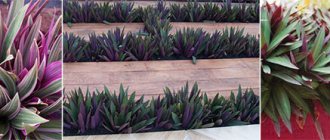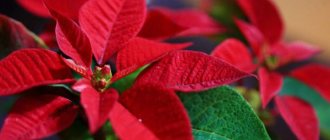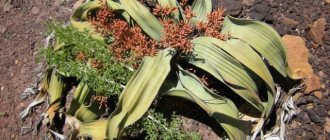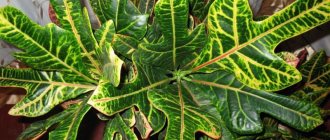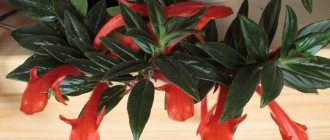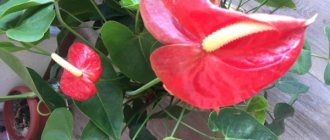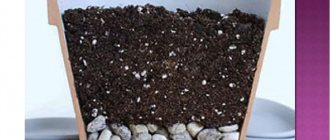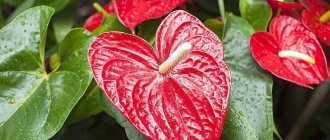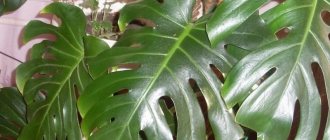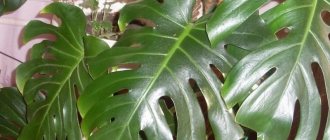Plants with decorative, colorful, large, bright and beautiful leaves add a special accent to the interior of any room. Sometimes you don’t need any other decor if you place a spectacular tree or bush on the table by the sofa in the living room.
Mostly the leaves of indoor plants are pink, but there are also purple and scarlet leaves. If you have long wanted to purchase an unusual bush that can transform a space with its appearance, we bring to your attention a list of beautiful indoor plants with colored leaves. In addition, most of them are not particularly demanding to care for, and therefore will take root well in your home.
Cordilina
A beautiful bush with decorative leaves, belonging to the Agave family and to the category of false palms. In general, there are many species of this plant, but some varieties are especially popular, since their plates are colored in certain shades in different intensities:
- Kiwi - intense crimson border;
- Apical - dark red color;
- Red - leaves, like fruits, can be from dark green to bright red;
- Purple compacta - most leaves are green, only a few have a dirty purple tint;
- Rumba - plates with white veins and scarlet edging;
- Tango is a small and neat tree with a lush tuft of leaves of an unusual brown color.
Caring for the plant does not require any special effort, but for the most decorative type of cordyline, you should follow some simple rules:
- diffused light;
- temperature regime - no higher than 22-23°C;
- moderate watering;
- During the growth period, fertilizing is required.
Classification of decorative foliage plants by air humidity
Shade-loving indoor plants and shade-tolerant flowers
Deciduous indoor plants exhibit different demands on ambient air humidity.
Note! Plants with large leaves require more air humidity than those with elongated and densely dissected leaves.
Moisture-loving
Moisture-loving species - Alocasia Kalidora, Aglaneoma Crete, decorative deciduous begonias.
Aglaneoma Crete
Codiaum species require very high air humidity in summer and winter. They are sprayed daily with warm water from a spray bottle. Calathea, despite its hard leaves, requires high air humidity, but does not tolerate elevated summer temperatures above 24 °C.
Calathea
The exception is the newer hybrid begonias, which are ever-blooming species with beautiful foliage, such as the Dragon's Wing begonia.
Drought resistant
Drought-resistant species include dracaenas. You can safely go on vacation, even in summer. These palm trees will tolerate lack of watering for 10-12 days without compromising their decorative qualities.
Note! If you plan not to water the flower for a longer period, it is recommended to use hydrogel.
Croton or codiaum
A wonderful plant that pleases with the unusualness of its variegated leaves. However, it is not easy to care for it, since the culture is quite capricious and demanding in terms of living conditions. So that the bush pleases with its beauty, does not lose its decorative effect and does not die, strictly adhere to the following conditions:
- loves bright light, but it is better to protect the plant from direct sunlight;
- temperature conditions are different: in summer - from 20 to 22°C, in winter - not lower than 16°C;
- You need to water regularly, but moderately;
- Be sure to fertilize with complex mineral fertilizer.
Be careful! The leaves and stems of croton secrete poisonous juice, which can cause not the most pleasant consequences: vomiting, indigestion, allergies. Therefore, when working with a plant, you must wear gloves!
What are succulents: videos and names
Succulents have excellent decorative properties. With their help you can decorate even a poorly lit interior. Succulents do not require high temperatures to thrive, but humidity levels do need to be high. Therefore, it is advisable to install some kind of fountain or aquarium next to the plant.
Detailed guide - Succulents: types and names with photos
There are many types of succulents. The most famous are aloe, agave, and wild Kalanchoe. But the most popular and famous are, perhaps, cacti. You can learn how to plant succulents by watching the video
Irezine
Belongs to the amaranth family, uniting as many as 80 species of various plants. The varieties of Linden and Herbst are especially loved by flower growers.
The flower is not poisonous and cleans and oxygenates the air in the room well.
Irezine does not require any special growing conditions, and can “live” well even with novice gardeners. Basics of care:
- sunlight is needed;
- air temperature - from 16 to 25°C;
- you need to water abundantly and regularly;
- timely pruning to maintain decorativeness;
- replanting is carried out after the old container is filled with roots, at least once every 2-3 years.
Classification of decorative foliage plants according to temperature conditions
For the most part, deciduous indoor flowers are heat-loving crops. In winter, they require lowering the indoor air temperature. However, pots should not be allowed to be kept on a cold floor where the temperature drops below 10 °C. The root system of deciduous flowers is sensitive to cold.
Heat-loving
Large indoor plants with large leaves
Heat-loving crops include those that require a temperature of 25-28 °C in summer and 20-22 °C in winter. A striking representative is Alocasia. This powerful plant is used in interiors as a solo plant. The leaves are very large and dark green in color.
For your information! There are varieties with striped coloring and wavy edges.
Alocasia calidora
Frost-resistant
For indoor culture, frost resistance is not so important. However, arrowroot is very well adapted to a wide range of conditions. Its leaves can be folded to retain moisture. The species tolerates cold and light frost.
Cold-resistant
Plant species that require a temperature drop to 8-10 °C in winter can tolerate temperatures of 18-22 °C in summer. Such crops include aucuba, araucaria, and lemon.
Coleus
Where there is no limit to imagination is coleus. In most species, the leaves are painted in bright, catchy shades. There are single-color plates, but there are varieties in which they are painted in several shades at once. These bushes look very beautiful, and they are completely easy to care for. Moreover, in the summer they can be taken out into the garden and sent indoors for the winter.
Coleus are often grown on balconies.
The basics of care include:
- needs a lot of bright sunlight, but it is better to shade the flower from direct rays;
- summer temperature - from 18 to 20°C, but not lower than 12°C;
- water regularly and quite abundantly;
- to maintain the decorative effect, the crown must be correctly shaped to create a lush bush;
- replant once every 3 or 4 years;
- With the onset of spring and until autumn, coleus plants are fertilized once a week.
Types of indoor trees and breeding conditions
Large plants in tubs perfectly decorate the interior. With proper watering, they provide lush greenery all year round. Of the existing species diversity, preference is often given to some variety that is undemanding in care. We’ll tell you in more detail about which specimens can be bred at home.
With constant employment, spending free time on hobbies and hobbies is an unaffordable luxury. Unpretentious varieties that do not require special conditions for growth and flowering are popular among apartment and house owners. The following varieties are common:
- citrus fruits (lemon, tangerine, orange, kumquat);
- exotic (breadfruit, bamboo, shefflera);
- ficuses (Benjamina, Bengal, rubber);
- palm trees (date, banana, rapis);
- bonsai (pine, spruce, sakura);
- flowering (hibiscus, abutilon).
The owners decide for themselves which species to give preference to. When making a choice, you should take into account the nuances. You need to determine in advance where the flower pot will be located. For the plant to be healthy, there must be enough lighting in the house. You should choose a flower carefully if there are small children and animals in the house. Some of the plants contain harmful substances that are hazardous to health.
Aglaonema
A species of tropical representatives that are very fond of professional flower growers and fans of indoor plants. Some varieties have beautiful wide leaf blades:
- Rounded - on a dark green background, thin red, carmine or pink stripes running along the veins are clearly visible.
- Red - Foliage can be red, pink or beet green.
- Crete is a fiery scarlet shade, on which green spots of varying degrees of intensity appear over time.
- Butterfly - combinations of red, yellow and deep marsh tones on one plate.
- Taivoli - the shade of the edging varies from pale pink to bright scarlet (the older the plant, the brighter the outline).
- Painted - a pattern on the leaves in the form of spots, varies in the silver-blue range.
Rules for keeping at home:
- diffused sunlight, slight shading;
- in winter without watering it can withstand up to +10 -15°C, in summer - +24°C;
- in the warm season, the soil should be moistened; in winter, watering should be reduced to once every 10 days;
- transplantation - once every 3 years.
Boxwood
The evergreen beauty grows up to 12 m in height. Garden boxwood can be grown in an apartment. Dense greenery, forming a dense crown, will decorate the design in an oriental style. Do not forget that boxwood is considered a long-liver. With proper care, it will delight its owners for many years.
The planted sprout grows slowly, up to 5 cm per year. Around the columnar trunk, many shoots are formed, covered with small glossy leaves.
There are more than 50 varieties of boxwood. The following varieties are suitable for growing at home:
- evergreen;
- small-leaved;
- Balearic.
The evergreen beauty requires circular pruning. Boxwood branches grow quickly. Regular pruning gives the plant a well-groomed appearance. A compact boxwood figure will be a wonderful decoration for an apartment or office. This decorative beauty perfectly purifies the air. It should be remembered that its stems and leaves are poisonous. It is not recommended to place boxwood in a nursery. Greens are also dangerous for pets.
Begonia Royal
A hybrid species of the Begoniaceae family. The flower is distinguished by asymmetrical leaves, which have a beautiful pattern and unusual color, varying depending on the varietal characteristics. The shades of the leaf plates can be completely different: cherry, scarlet, pale pink, violet-green pattern and burgundy edging, rich red and others.
Basic growing rules:
- thanks to the large amount of diffused sunlight, the bush will delight with a bright crown;
- optimal temperature - 25°C;
- loves moist soil, but does not tolerate stagnation of moisture in the pot;
- perfectly tolerates frequent spraying;
- requires regular feeding.
Dieffenbachia
It grows up to two meters in height. The motley guest from the sunny tropics is demanding in care. She cannot stand drafts and cold. Uneven watering leads to yellowing of the leaves. In order for the leaf to retain its rich green color, it is necessary to spray with warm water.
Dieffenbachia can liven up a boring apartment interior. But not everyone knows that its juice is poisonous. When it comes into contact with human skin, irritation occurs. If the juice splashes into the eyes, vision problems may occur. In a family where there are small children and animals, Dieffenbachia should not be bred.
Hypoestes
A genus of tropical plants of the Acanthus family. It has amazing foliage color, resembling a face covered with rainbow freckles. Perfect for those who like brightness in the interior. This is a type of branched shrub with unusual leaf blades. The main feature of the plant is the presence on the surface of many dots of different shades: red, white, pink, purple. Well, just like freckles!
The bush is quite unpretentious, it is very easy to care for:
- grows both in small rooms (but with good lighting!) and in the garden with other moisture-loving ornamental plants;
- temperature - from 22 to 25°C, but not less than 17 degrees;
- watering should be plentiful;
- To make the foliage brighter and the shade more clearly visible, use fertilizer with a high potassium content.
Using decorative foliage plants for interior decoration
It is important to remember that annuals are almost never used for interior landscaping. Decorative foliage plants are arranged in groups in accordance with the shape and color of foliage, height, branching and spreading. A combination of balanced harmony is used. A very fashionable trend is hedges and walls in offices, foyers and other rooms.
Green wall of decorative foliage plants
Any room is noticeably transformed if it has decorative foliage flowers. By following the recommendations, you can create a magnificent interior and improve the microclimate of the room. Leaves absorb carbon dioxide, adsorb dust and other harmful particles, and enrich the space with oxygen.
Nesquik Opti-Start instant cocoa drink, 1 kg (package)
316 ₽ More details
Nesquik Opti-Start instant cocoa drink, 1 kg (package)
339 ₽ More details
Bouquets for the bride
Maranta
A tropical flower with an unusual color. The foliage itself is bright green, with clearly visible spots and veins of a red hue. The plant does not require special care. The main thing is to maintain optimal temperature conditions, water in a timely manner, trim dry leaves and replant 2 times a year with the arrival of spring.
An interesting feature of arrowroot is that the upper surface of the leaves is much brighter than the lower surface. This is more than noticeable when the bush lifts its leaves in the evening and folds them slightly.
Bonsai
It is a miniature copy of a tree. The idea of growing dwarfs in pots came to us from China. Asian bonsai is not just a small flower in a pot. It is an object of art and the embodiment of living sculpture. Growing miniature trees is a kind of ritual, the purpose of which is to create a smaller copy of nature.
Growing bonsai requires special skills and patience. Coniferous and fruit trees, as well as specimens with small curly leaves, are suitable for propagation. Beautiful bonsai are obtained from climbing willow and birch. A rooted seedling is planted in a pot. Lawn grass is sown around it for aesthetics. For several years, the Christmas tree or birch tree is well looked after, giving it the desired shape. This is achieved by pruning old branches and pinning new shoots. All this time, the bonsai needs to be watered in a timely manner and fed as needed. If you monitor the growth of shoots and regulate their growth, over time you can get an elegant dwarf mini-tree.
Ginura
An evergreen subshrub with delicate velvety leaves, which are sometimes colored purple underneath. This creates an unusual feeling. The veins on the plates can also be painted in a similar color.
The plant is not capricious, great for beginner gardeners:
- bright light, but in the hot season it is better to shade the bush;
- temperature - from 18 to 24°C;
- water abundantly as soon as the top layer of soil dries out;
- feed during active growth once every two weeks.
Subscribe to our Social networks
Ferns
If you need to add greenery to a shaded corner of your apartment, you should put a fern on the shelf. A beautiful green bush hanging down will decorate any interior.
Ferns in nature grow in the shade of tall trees, so low light for them is not an obstacle to the lush growth of carved greenery. It is recommended to place pots with ferns on the western, eastern or northern side of the house. These indoor flowers have several types.
One of the most decorative ferns is considered to be the adiantum with delicate, lush green leaves.
Ferns are planted in a tight container and watered abundantly. The best watering is to place the flowerpot in a basin of settled water, and then allow the excess moisture to drain.
Loves spraying, good ventilation and shaded areas. Sunburn can kill you.
Conifers
Small thujas, evergreen coniferous trees, have become widespread in indoor floriculture. The beneficial advantages of thuja are known: endurance, unpretentiousness, beautiful appearance, and the ability to purify the air of toxins.
Thujas do not need bright light. And the sun's rays seem to burn out the emerald color of the tree, depriving it of its attractiveness.
Clivia
A very interesting decorative flowering plant, native to South Africa. The high humidity of this area allows clivia to grow here too. You can place the pot in any convenient corner of the house.
You can water your plants in different ways by simply checking the soil moisture. The main thing is not to create excess moisture. Clivia feels completely comfortable even in a small hallway, where there is only artificial lighting. It blooms starting in February. This is a real holiday! Many bright orange small flowers gather together to create a colorful cap.
If your crazy work schedule does not allow you to devote much time to flowers, then clivia is perfect.
Phalaenopsis orchid
This type of decorative flowering indoor plant is loved by many representatives of the fair sex. An orchid is very often chosen as a gift because it combines the beauty of a flower and durability.
The plant is unpretentious in care and loves slightly shaded places. The eastern part of the house or apartment is perfect.
An unusual detail of orchids is their aerial roots, which are located not only in the pot, but also on top of it. The color of the flowers may vary.
Spathiphyllum
If you want to decorate your room with a more delicate and classic flower, then choosing spathiphyllum is a great solution. Don’t be intimidated by its complicated name: it is easy to care for, and therefore would be an excellent gift for a young couple or anyone who has had no previous experience in growing flowers.
The excuse “Nothing survives for me!” it is not afraid, because spathiphyllum can withstand lack of watering and lack of sunlight.
This decorative flowering plant looks very delicate. The interesting contrast of rich dark green stems and leaves is complemented by a snow-white flower, so reminiscent of calla lilies. Its beauty can be observed all year round.
Saintpaulia (Usambara violet)
They simply call it violet, and you can find such a flower in almost any home. This popularity is due to the simple rules of care and the compact size of the plant, which allows you to place the pot even on a tiny windowsill.
Violet flowers are unusual. The very traditional shape is complemented by an interesting surface made of a large number of fibers, thanks to which it literally becomes fluffy. The color of the flower depends on the variety, but it is always deep and rich.
Do not water the plant directly at the root. Its leaves are prone to the formation of harmful mold, so water is added to the tray where the pot stands, and Saintpaulia itself absorbs moisture.
When the violet is actively blooming, it is watered only twice a month, and the soil in the pot is covered with moss. It turns out something like a fabulous mini-lawn.
Secrets for making everblooming houseplants bloom
Each species has its own methods to help induce flowering. The most common:
- To make the orchid bloom again faster, put it in a dark, cool room for a month and reduce watering.
- Violets bloom in sunlight for at least 8 hours. In winter, artificial lighting is added and daylight hours are extended to 14 hours.
- The indoor rose is replanted at the end of summer. In the spring, weak, dry shoots are cut off and a long daylight hours of at least 16 hours is provided.
- Abutilon blooms all year round in bright light.
Ever-blooming house flowers will decorate and diversify your life. They give positive emotions and are pleasing to the eye. Flowers in the house lift your spirits and support physical health. From the many species and varieties, a gardener can easily choose which one is suitable for the home.
Sources
- https://stroy-podskazka.ru/komnatnye-cvety/samye-neprihotlivye/
- https://gardenaddict.ru/komnatnye/cvety/cvetushhie-kruglyj-god.html
- https://www.nur.kz/1719482-komnatnye-cvety-cvetusie-kruglyj-god.html
- https://CvetnikInfo.ru/komnatnye-tsvety/tsvety-v-komnate-tsvetushhie-kruglyj-god.html
- https://doma-v-sadu.ru/komnatnye-rasteniya/neprihotlivye.html
- https://mirfermera.ru/442-neprihotlivye-komnatnye-rasteniya-foto-i-nazvaniya.html
- https://greenerydom.ru/articles/neprihotlivye-komnatnye-rasteniya.php
- https://zen.yandex.ru/media/id/5c74169a6dc7c000aeb0f4ab/5d9da6771ee34f41895508c9
- https://dm-st.ru/neprihotlivye-komnatnye-rasteniya-tsvetushchie-kruglyy-god
- https://stroy-podskazka.ru/komnatnye-cvety/cvetushchie-kruglyj-god/
- https://www.flowerbank.ru/?p=4499
- https://Lifehacker.ru/20-neubivaemyx-rastenij/
- https://homebuilding.ru/21-rastenie-malo-sveta.html
- https://tytdacha.ru/tsvety-i-rasteniya/komnatnye-rasteniya/neprihotlivye-komnatnye-rasteniya/
- https://greensotka.ru/tsvetushchie/komnatnye-tsvety-tsvetuschie-krugliy-god.html
Ethiopian calla
Another representative of an unpretentious group of plants. Like spathiphyllum, it is suitable for lovers of classics and tenderness. A change in temperature, for example, before the onset of the heating season, will not affect the condition of the flower.
The plant will be able to show all its beauty in November and will delight the eye until May. Calla lilies rest almost all summer. During this period, it is necessary to water it less and not change the location of the pot or disturb it.
From time to time, dead leaves are removed from the flower, in place of which new ones appear.
Decorative flowering plants are a salvation from melancholy and blues at any time of the year. Rooms need such a lively and bright interior element. Simple care will not burden the owner, and beautiful flowers will lift your spirits!
Literature
- Tulintsev V.G.
Ornamental gardening. - M.; L.: State. publishing house of agricultural literature, 1950. - 432 p. — (Textbooks and teaching aids for agricultural technical schools). — 25,000 copies. (in translation) - Golovkin B.N. et al.
Ornamental plants of the USSR. - M.: Mysl, 1986. - 320 p. - Poletiko O. M., Mishenkova A. P.
Ornamental herbaceous plants of open ground. Handbook of nomenclature of genera and species. - L.: Science, 1967. - Hessayon D. G.
All about ornamental trees and shrubs. - M.: Kladez-Books, 2005. - ISBN 5-93395-121-8. - Krestnikova A. D.
Decorative perennials. - M.: Rosselkhozizdat, 1987. - 62 p. - Hessayon D. G.
All about flowers in your garden. - M.: Kladez-Books, 2006. - 256 p. — ISBN 5-93395-062-9. - Hessayon D. G.
All about indoor plants. - M.: Kladez-Books, 2000. - 256 p. — ISBN 0-903505-35-5. - Handbook of ornamental trees and shrubs of the European part of the USSR. - M.: Ministry of Communal Services of the USSR, 1953.
